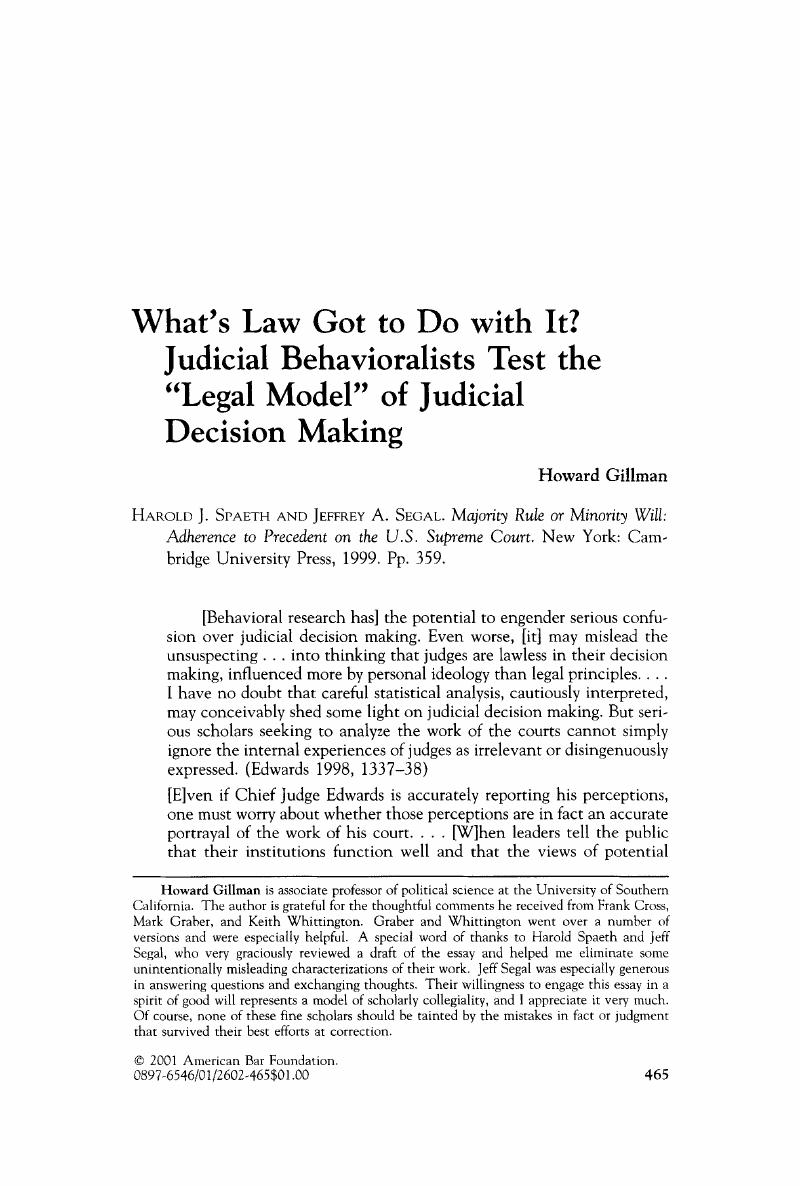Crossref Citations
This article has been cited by the following publications. This list is generated based on data provided by Crossref.
Lovell, George I.
2001.
Legislative Deferrals.
Graber, Mark A.
2002.
Constitutional Politics and Constitutional Theory: A Misunderstood and Neglected Relationship.
Law <html_ent glyph="@amp;" ascii="&"/> Social Inquiry,
Vol. 27,
Issue. 2,
p.
309.
Howard, Robert M.
and
Segal, Jeffrey A.
2002.
An Original Look at Originalism.
Law & Society Review,
Vol. 36,
Issue. 1,
p.
113.
DeMoss, Karen
2003.
Who's Accountable to the Constitution? Thirty Years of Judicial Politics in State Education Finance Litigation.
Peabody Journal of Education,
Vol. 78,
Issue. 4,
p.
44.
Baum, Lawrence
2003.
THESUPREMECOURT INAMERICANPOLITICS.
Annual Review of Political Science,
Vol. 6,
Issue. 1,
p.
161.
Klein, David E.
and
Hume, Robert J.
2003.
Fear of Reversal as an Explanation of Lower Court Compliance.
Law & Society Review,
Vol. 37,
Issue. 3,
p.
579.
Silverstein, Gordon
2005.
The Warren Court, Congress and the First Amendment: The Road Not Taken?.
The Good Society,
Vol. 14,
Issue. 1-2,
p.
67.
Silverstein, Gordon
2005.
The Warren Court, Congress and the First Amendment: The Road Not Taken?.
The Good Society,
Vol. 14,
Issue. 1-2,
p.
67.
Feldman, Stephen M.
2005.
The Rule of Law or the Rule of Politics? Harmonizing the Internal and External Views of Supreme Court Decision Making.
Law <html_ent glyph="@amp;" ascii="&"/> Social Inquiry,
Vol. 30,
Issue. 1,
p.
89.
Gerstmann, Evan
2005.
Litigating Same-Sex Marriage: Might the Courts Actually Be Bastions of Rationality?.
PS: Political Science & Politics,
Vol. 38,
Issue. 2,
p.
217.
Scofield, Robert G
2005.
Goodhart's Concession: Defending Ratio Decidendi from Logical Positivism and Legal Realism in the First Half of the Twentieth Century.
King's Law Journal,
Vol. 16,
Issue. 2,
p.
311.
Scott, Kevin M.
2006.
Reconsidering the Impact of Jurisprudential Regimes*.
Social Science Quarterly,
Vol. 87,
Issue. 2,
p.
380.
Lindquist, Stefanie A.
and
Klein, David E.
2006.
The Influence of Jurisprudential Considerations on Supreme Court Decisionmaking: A Study of Conflict Cases.
Law & Society Review,
Vol. 40,
Issue. 1,
p.
135.
Wilson, Esq., Dr. Sean
2006.
The Attitudinal Model, Political Science, Ecological Fallacy and Exaggeration.
SSRN Electronic Journal,
Friedman, Barry
2006.
Taking Law Seriously.
Perspectives on Politics,
Vol. 4,
Issue. 02,
Keck, Thomas M.
2007.
Party Politics or Judicial Independence? The Regime Politics Literature Hits the Law Schools.
Law & Social Inquiry,
Vol. 32,
Issue. 2,
p.
511.
Buchman, Jeremy
2007.
The Effects of Ideology on Federal Trial Judges' Decisions to Admit Scientific Expert Testimony.
American Politics Research,
Vol. 35,
Issue. 5,
p.
671.
Braman, Eileen
and
Nelson, Thomas E.
2007.
Mechanism of Motivated Reasoning? Analogical Perception in Discrimination Disputes.
American Journal of Political Science,
Vol. 51,
Issue. 4,
p.
940.
Whytock, Christopher A.
2007.
Politics and the Rule of Law in Transnational Judicial Governance: The Case of Forum Non Conveniens.
SSRN Electronic Journal,
KECK, THOMAS M.
2007.
Party, Policy, or Duty: Why Does the Supreme Court Invalidate Federal Statutes?.
American Political Science Review,
Vol. 101,
Issue. 2,
p.
321.





